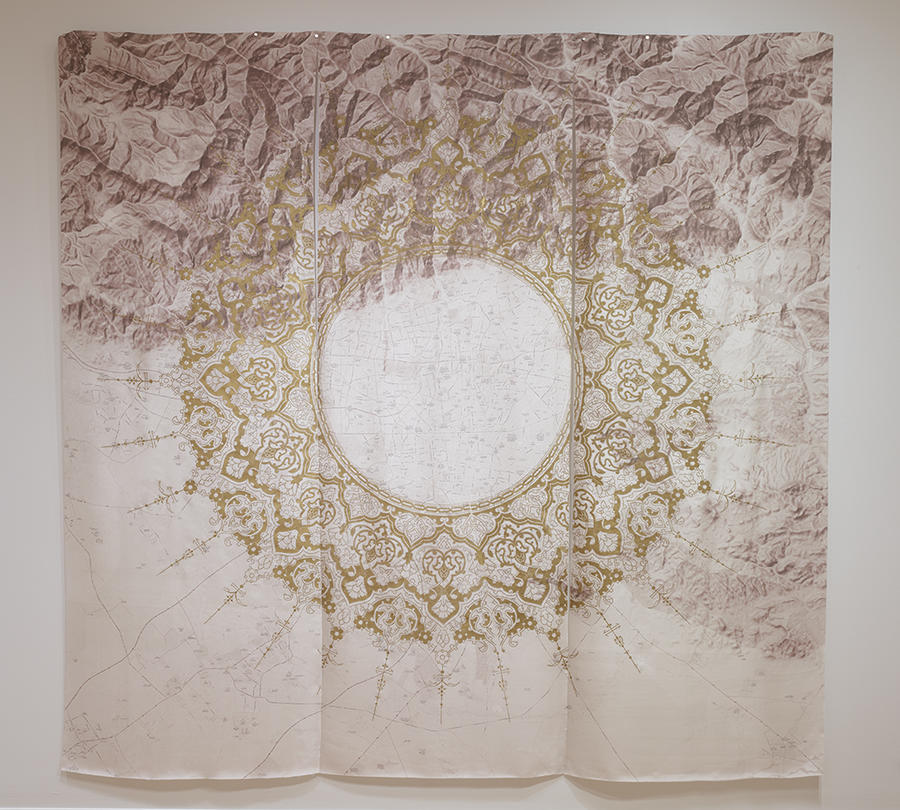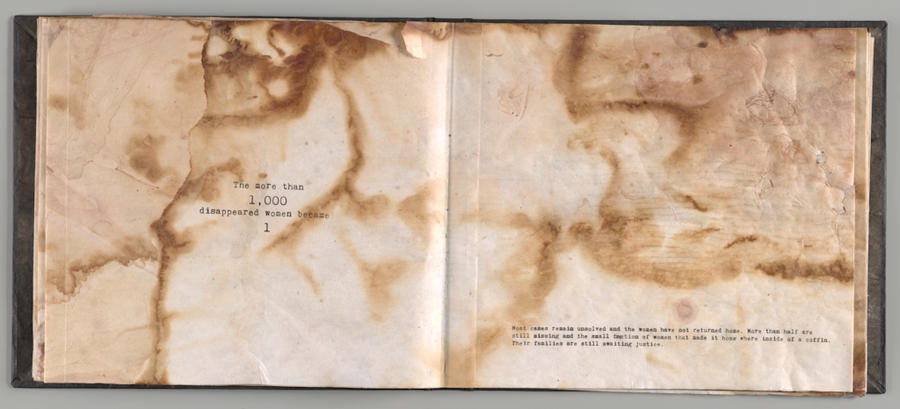On Focus: Rhode Island School of Art and Design Museum of Art's exhibit "Un/Settled"
Un/Settled, currently open at the Rhode Island School of Design (RISD) Museum until July 8th 2018, encompasses a wide variety of prints, drawings and photographs that promise a unique and intriguing exhibition to appease anyone. The exhibition works in conjunction with RISD alumni, and holds around ten differentiating art works on the topic of their birthplace from a globalized perspective. Taking inspiration from fellow RISD alumni Tia Blassingame’s novel Settled: African American Sediment or Constant Middle Passage, the exhibition follows a strict narrative of cultural identity through international dislocation with the inclusion of artists both from foreign and national areas.
The exhibition is closely tucked away through the Modern and Contemporary New Mediums wing on the third floor, and as it is not listed on the confusing layout of the museum guide, it can be tricky to find the room. Once entering the Buonanno Works On Paper Gallery, you’re greeted by art of many forms, and unknowingly, you have to turn around to see the main text introduction. The introduction broadly overviews the purpose and attribution of each piece, introduces an experimental idea of art descriptions being written by the artist themselves, and emphasizes the connection to Blassingame’s novel. The name, Un/Settled, is presented in a way that the “U” and the “S” are the only words not in bold, possibly symbolizing the connection between the RISD artists feeling unsettled in the United States (US). The text leaves you cut short, as you are left to freely wander around the one room exhibition as a self-guided tour, engulfing yourself in the artist’s own interpretation of their relationship with their culture.
Main highlights include “Glory” by Saman Sajasi, “British Invasion at the Punjabi Deli Part 2: Dreaming of that Chai Chai” by Jagdeep Raina, “There's So Many of Us (2)” by Arghavan Khosravi, and “Memento Mori” by Nabil Gonzalez. Each highlight a personal connection to different nations, including but not limited to Mexico, Pakistan, India, Iran, Italy, USA, Korea, and more. In Sajasi’s grandiose installation of a silk triptych, a detailed map of Iran is adorned with Islamic artistic features and an oculus-shaped figure focusing on the center. Sajasi describes her piece as “My art originates in my complicated relationship with my culture...I am Iranian. I am American”. This work acknowledges the social aspect of the topic, and is appropriately accompanied with a sitting bench to study its intricacies. Gonzalez’ work of art is a personalized artist book drenched in watercolor and tea stains, giving it a rustic appeal to the viewer. Gonzalez takes a more political approach to the topic of cultural identity, creating a propagandistic rendering of a full length record of Mexican women deaths due to drug cartel violence. Gonzalez shares, “I create memorials for a faceless fraction of society by acknowledging their existence and re establishing their human identities…”, which shows the extent of identity when looking at your culture from another perspective. Overall, the pieces shown play an enormous role in the several elements of cultural identity, and each contribute an important point to this globalized discussion.
In general, the exhibition has a non structurized free movement pathway, which can take away the importance, but works perfectly for the space dedicated to the show. Each piece is unique, and its personalized description assists the viewers personal connection with the art, the artist, and the culture shown. Un/Settled gives off a sublime ambiance of international despair with a hint of hope, aided by the quality of the pieces chosen, the cleasiness, the lighting, and more. Its constant references and inclusion of Blassingname’s novel seems out of place and unexplained fully, but help retain a connection to the overall topic and the RISD alumni specifically.
Un/Settled brings unknown recently graduated students to importance, and sheds light on the diversity and oppression present by and in this nation. The topic chosen is of special importance in today’s political climate, and can be related to by any foreign student, immigrant, or anybody that has a place to call home.
This is an outdated article, yet I felt necessary posting it for archival purposes.
Un/Settled, currently open at the Rhode Island School of Design (RISD) Museum until July 8th 2018, encompasses a wide variety of prints, drawings and photographs that promise a unique and intriguing exhibition to appease anyone. The exhibition works in conjunction with RISD alumni, and holds around ten differentiating art works on the topic of their birthplace from a globalized perspective. Taking inspiration from fellow RISD alumni Tia Blassingame’s novel Settled: African American Sediment or Constant Middle Passage, the exhibition follows a strict narrative of cultural identity through international dislocation with the inclusion of artists both from foreign and national areas.
The exhibition is closely tucked away through the Modern and Contemporary New Mediums wing on the third floor, and as it is not listed on the confusing layout of the museum guide, it can be tricky to find the room. Once entering the Buonanno Works On Paper Gallery, you’re greeted by art of many forms, and unknowingly, you have to turn around to see the main text introduction. The introduction broadly overviews the purpose and attribution of each piece, introduces an experimental idea of art descriptions being written by the artist themselves, and emphasizes the connection to Blassingame’s novel. The name, Un/Settled, is presented in a way that the “U” and the “S” are the only words not in bold, possibly symbolizing the connection between the RISD artists feeling unsettled in the United States (US). The text leaves you cut short, as you are left to freely wander around the one room exhibition as a self-guided tour, engulfing yourself in the artist’s own interpretation of their relationship with their culture.
 |
| Glory Saman Sajasi |
Main highlights include “Glory” by Saman Sajasi, “British Invasion at the Punjabi Deli Part 2: Dreaming of that Chai Chai” by Jagdeep Raina, “There's So Many of Us (2)” by Arghavan Khosravi, and “Memento Mori” by Nabil Gonzalez. Each highlight a personal connection to different nations, including but not limited to Mexico, Pakistan, India, Iran, Italy, USA, Korea, and more. In Sajasi’s grandiose installation of a silk triptych, a detailed map of Iran is adorned with Islamic artistic features and an oculus-shaped figure focusing on the center. Sajasi describes her piece as “My art originates in my complicated relationship with my culture...I am Iranian. I am American”. This work acknowledges the social aspect of the topic, and is appropriately accompanied with a sitting bench to study its intricacies. Gonzalez’ work of art is a personalized artist book drenched in watercolor and tea stains, giving it a rustic appeal to the viewer. Gonzalez takes a more political approach to the topic of cultural identity, creating a propagandistic rendering of a full length record of Mexican women deaths due to drug cartel violence. Gonzalez shares, “I create memorials for a faceless fraction of society by acknowledging their existence and re establishing their human identities…”, which shows the extent of identity when looking at your culture from another perspective. Overall, the pieces shown play an enormous role in the several elements of cultural identity, and each contribute an important point to this globalized discussion.
 |
| Memento Mori Nabil Gonzalez |
In general, the exhibition has a non structurized free movement pathway, which can take away the importance, but works perfectly for the space dedicated to the show. Each piece is unique, and its personalized description assists the viewers personal connection with the art, the artist, and the culture shown. Un/Settled gives off a sublime ambiance of international despair with a hint of hope, aided by the quality of the pieces chosen, the cleasiness, the lighting, and more. Its constant references and inclusion of Blassingname’s novel seems out of place and unexplained fully, but help retain a connection to the overall topic and the RISD alumni specifically.
Un/Settled brings unknown recently graduated students to importance, and sheds light on the diversity and oppression present by and in this nation. The topic chosen is of special importance in today’s political climate, and can be related to by any foreign student, immigrant, or anybody that has a place to call home.
Comments
Post a Comment